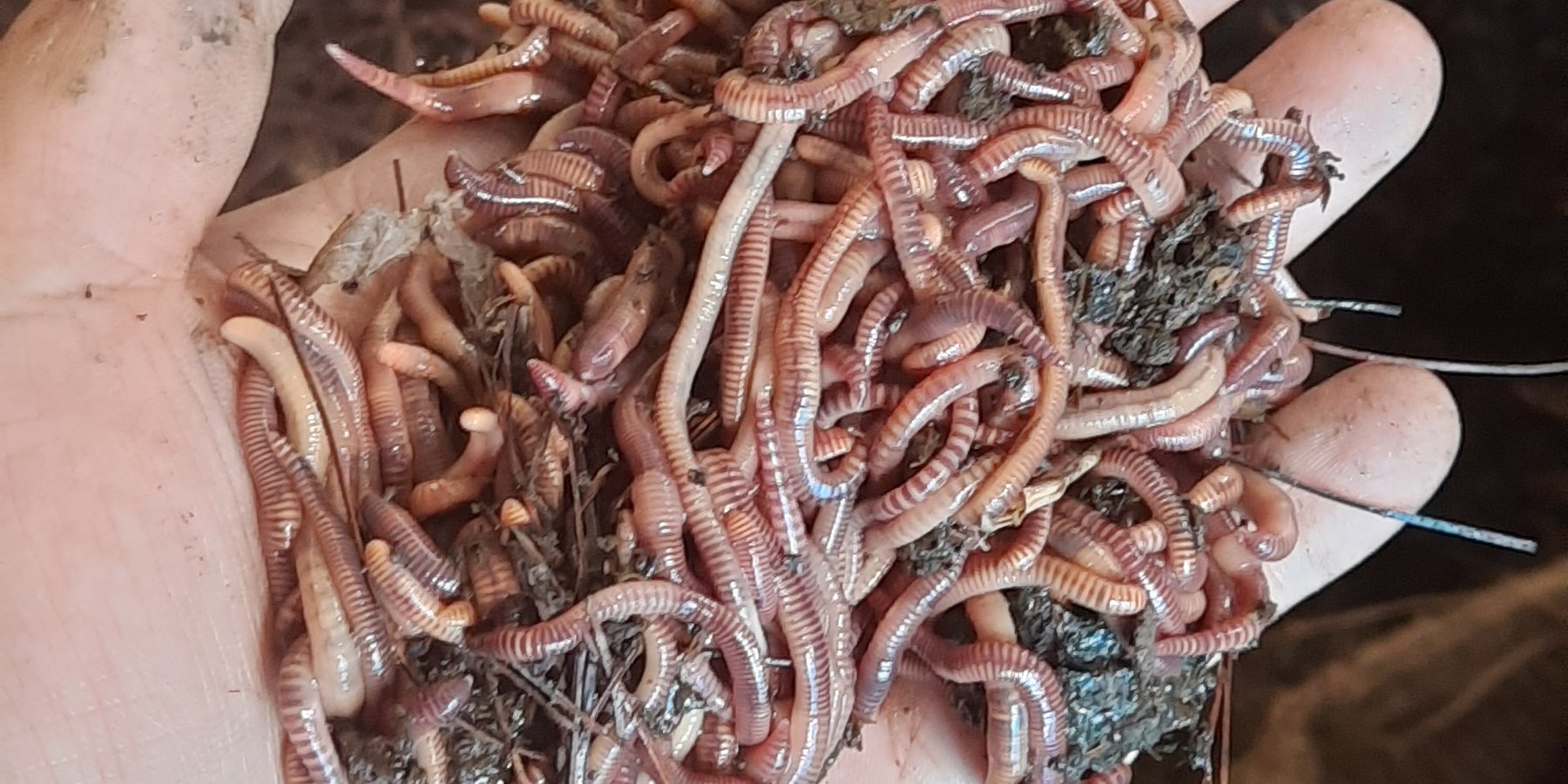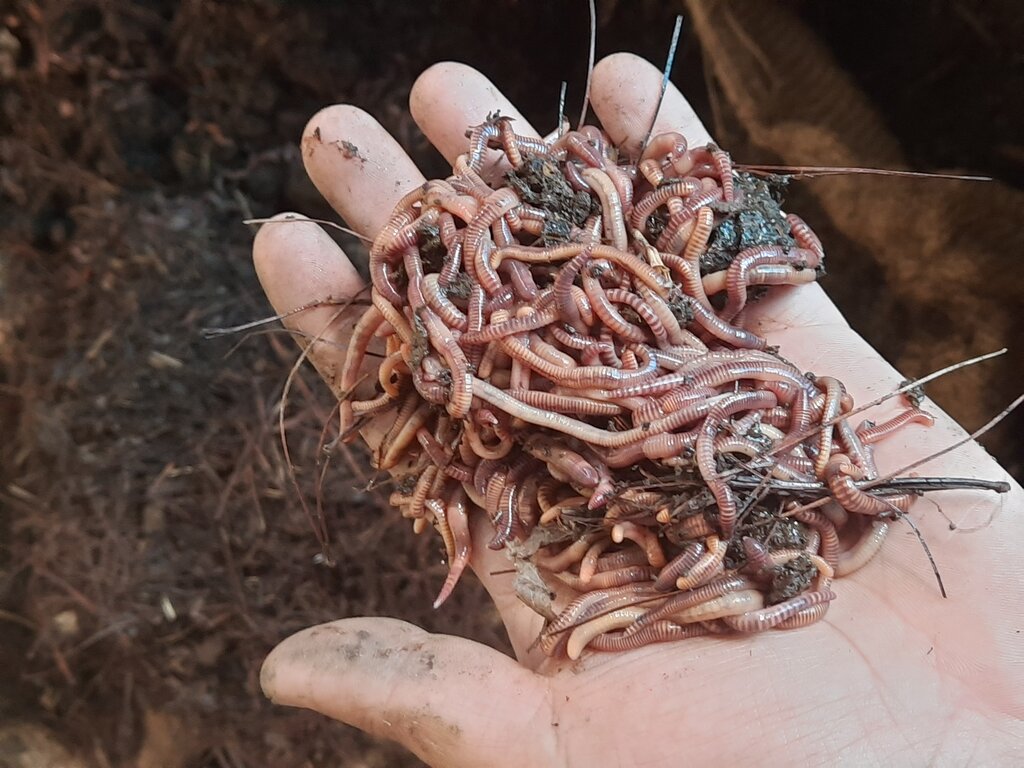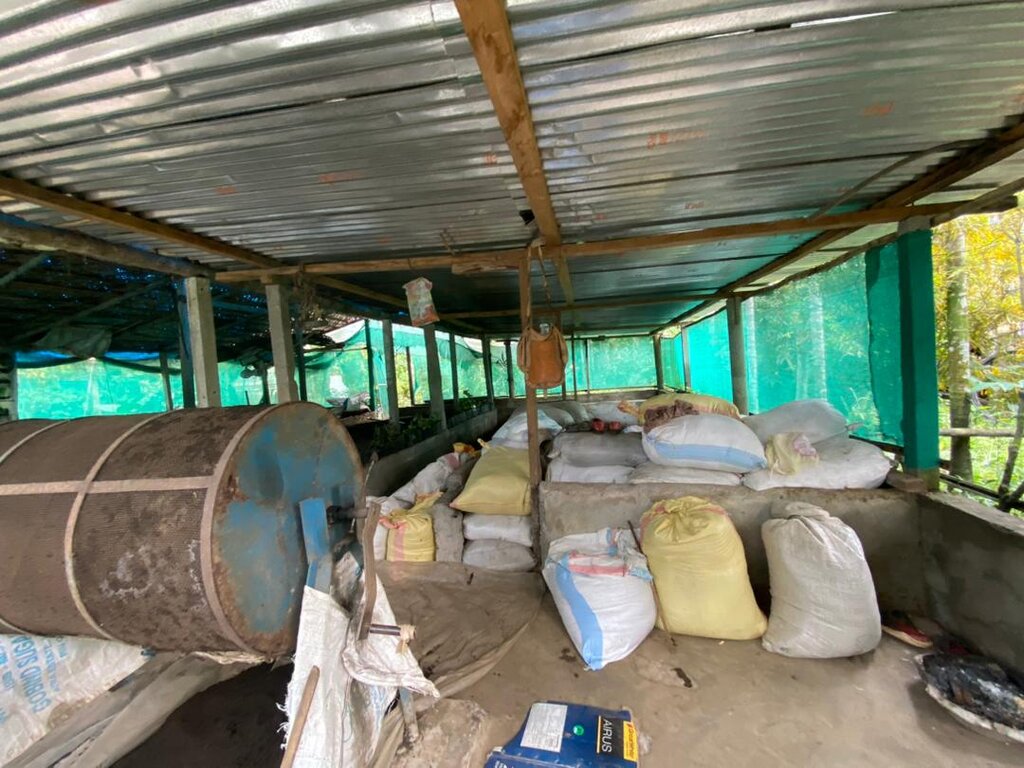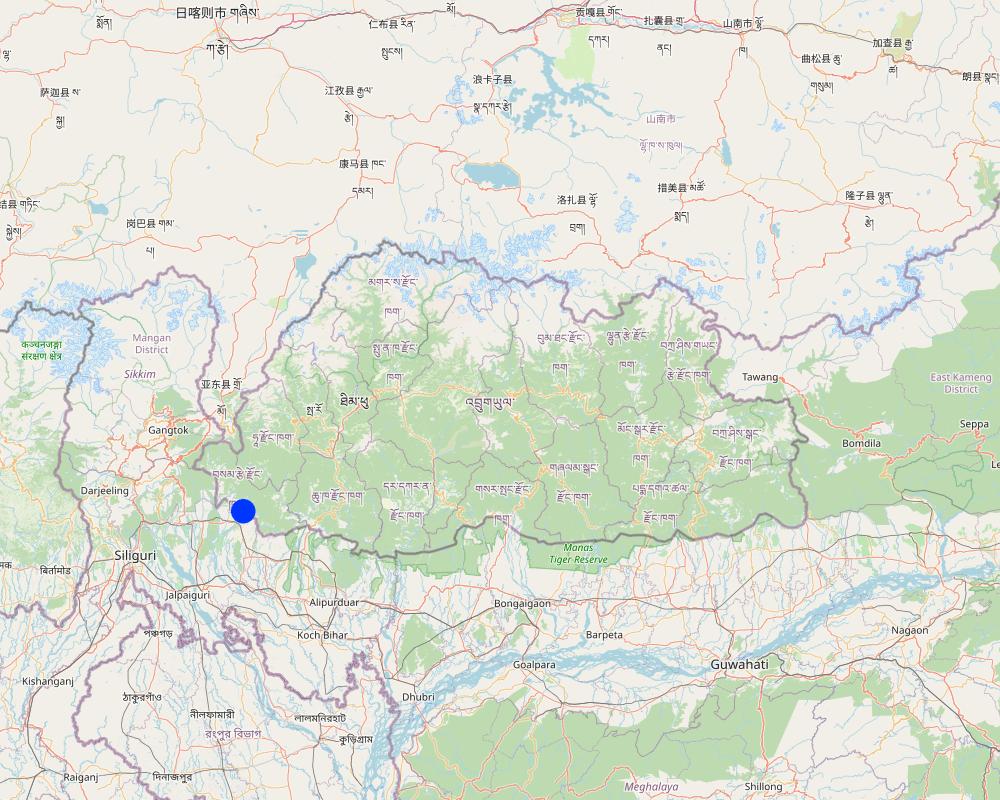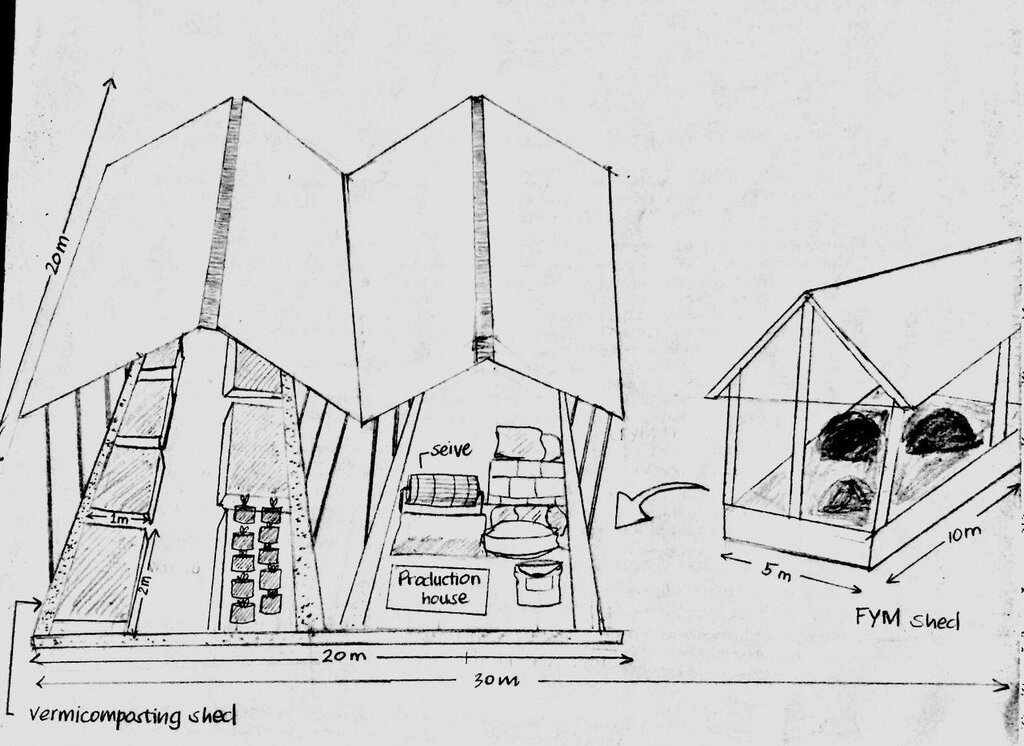Vermicomposting [Bhutan]
- Creation:
- Update:
- Compiler: Karma Wangdi
- Editor: Kuenzang Nima
- Reviewers: William Critchley, Rima Mekdaschi Studer
Chongboob Lue Zhoni (ལྕོང་འབུབ་ལུད་བཟོ་ནི།)
technologies_6874 - Bhutan
View sections
Expand all Collapse all1. General information
1.2 Contact details of resource persons and institutions involved in the assessment and documentation of the Technology
Key resource person(s)
land user:
Gurung Divya
Norbugang
Bhutan
Name of project which facilitated the documentation/ evaluation of the Technology (if relevant)
Strengthening national-level institutional and professional capacities of country Parties towards enhanced UNCCD monitoring and reporting – GEF 7 EA Umbrella II (GEF 7 UNCCD Enabling Activities_Umbrella II)1.3 Conditions regarding the use of data documented through WOCAT
The compiler and key resource person(s) accept the conditions regarding the use of data documented through WOCAT:
Yes
1.4 Declaration on sustainability of the described Technology
Is the Technology described here problematic with regard to land degradation, so that it cannot be declared a sustainable land management technology?
No
Comments:
This technology does not pose any land degradation problems
2. Description of the SLM Technology
2.1 Short description of the Technology
Definition of the Technology:
Vermicomposting is the practice of composting organic waste products with the aid of various types of worms. These worms aid the decomposition of organic materials, including kitchen leftovers and yard trash, resulting in the production of compost that is abundant in nutrients.
2.2 Detailed description of the Technology
Description:
Vermicomposting is where organic wastes are broken down by redworms (Eisenia fetida or Lumbricus rubellus) and other types of earthworms. The worms produce nutrient-rich castings, which are valuable natural fertilizers for plants and enhance soil health. Vermicomposting is an effective and environmentally acceptable approach to recycle organic waste and produces a valuable resource for farming and gardening (Grant, 2021).
The raw substrate is initially ground in the gizzard to create smaller particles, increasing the surface area during the vermicomposting process. Earthworm gut microorganisms and digestive enzymes continue to work on the material to create a fine granular product that is rich in healthy nutrients and microbiota (Sharma & Garg, 2017). Vermicomposting is popular in urban gardening and horticulture, where space and resource constraints are common.
It is a sustainable and effective method for managing organic waste because it combines a number of essential traits and components. Firstly, it involves the usage of particular types of earthworms, such Eisenia fetida (red wigglers), which are renowned for their capacity to ingest enormous quantities of organic material. Maintaining optimum moisture levels, typically between 60 and 80 percent, is necessary for efficient vermicomposting. Another crucial component is aeration, which encourages aerobic decomposition and reduces odour. Vermicompost bins or beds are made with sufficient drainage and ventilation systems to do this. The ideal temperature range is between 15 o to 30 o C (Adhikary, 2012). Vermicomposting's goals and functions include waste reduction, improved soil fertility, soil restoration, sustainable agriculture, and easily accessible waste management.
Vermiculture encourages eco-friendly gardening and supports sustainable agriculture methods by limiting the use of chemical fertilizers. The initial expense and time needed to set up a vermicomposting system are two significant drawbacks. Another difficulty is the requirement for constant monitoring and upkeep, including controlling moisture levels, ensuring adequate aeration, and controlling temperature conditions. Poor environmental care can result in bad smells or even the death of earthworms.
Samtse's first and only vermicomposting facility in Norbugang gewog is performing successfully. The project, which began on a couple's farm near Bhimtar in December 2013, employs earthworms to convert organic waste into high-quality compost. It is the end result of the decomposition of organic elements by earthworms. The dzongkhag's assistant agricultural officer (ADAO) spearheaded the idea of establishing the compost plant, with assistance from the national organic program. The main substrate used for vermicomposting is cow dung and banana stems. The mixture is spread out as a bed inside the compost house for the earthworms to feed. The worms break down the mixture to produce vermicompost.
Initially, a kilogram of red earthworms (Eisenia foetida) were cultivated in a nursery. In a month, the nursery produced 10 kg, which was then employed in the project. According to Dibya Gurung, the worms needed 28 days to feed on the organic wastes in the existing compost house environment. Bhutanese farmers utilize vermicompost as a nutrient-rich organic fertilizer to enhance soil fertility and improve crop yields. This promote sustainable agriculture practices and reduce dependence on chemical fertilizers, aligning with Bhutan's goal of achieving food self-sufficiency.
There are currently 12 organic fertilizer producers in the Bhutan producing various types of compost, including vermi-compost, liquid fertilizer, bio-slurry compost, chicken manure, and EM solution. However, there is no record of a dedicated vermiculture enterprise in the nation, even though worms are required to make compost organic fertilizer, according to the National Soil Services Centre (NSSC), Department of Agriculture (DoA). For instance, the country generated 8130MT of organic fertilizers, according to the NSSC's annual report for 2021–2022 (Dorji, 2022).
2.3 Photos of the Technology
2.5 Country/ region/ locations where the Technology has been applied and which are covered by this assessment
Country:
Bhutan
Region/ State/ Province:
Samtse
Further specification of location:
Norbugang
Specify the spread of the Technology:
- applied at specific points/ concentrated on a small area
Is/are the technology site(s) located in a permanently protected area?
No
Map
×2.6 Date of implementation
If precise year is not known, indicate approximate date:
- less than 10 years ago (recently)
2.7 Introduction of the Technology
Specify how the Technology was introduced:
- through projects/ external interventions
Comments (type of project, etc.):
National Organic Flagship Program
3. Classification of the SLM Technology
3.1 Main purpose(s) of the Technology
- improve production
- conserve ecosystem
- preserve/ improve biodiversity
- create beneficial economic impact
3.2 Current land use type(s) where the Technology is applied

Cropland
- Floriculture
Is intercropping practiced?
Yes
If yes, specify which crops are intercropped:
na
Is crop rotation practiced?
No
Comments:
Only floriculture is done
3.3 Has land use changed due to the implementation of the Technology?
Has land use changed due to the implementation of the Technology?
- No (Continue with question 3.4)
Land use mixed within the same land unit:
No
Comments:
floriculture is done
3.4 Water supply
Water supply for the land on which the Technology is applied:
- full irrigation
3.5 SLM group to which the Technology belongs
- integrated soil fertility management
- waste management/ waste water management
- home gardens
3.6 SLM measures comprising the Technology

structural measures
- S8: Sanitation/ waste water structures

management measures
- M6: Waste management (recycling, re-use or reduce)
3.7 Main types of land degradation addressed by the Technology

other
Specify:
Improve soil fertility management
Comments:
na
3.8 Prevention, reduction, or restoration of land degradation
Specify the goal of the Technology with regard to land degradation:
- reduce land degradation
- restore/ rehabilitate severely degraded land
4. Technical specifications, implementation activities, inputs, and costs
4.1 Technical drawing of the Technology
Technical specifications (related to technical drawing):
The technology is located in five acres land
Author:
Niki Rai
Date:
20/07/2023
4.2 General information regarding the calculation of inputs and costs
Specify how costs and inputs were calculated:
- per Technology unit
other/ national currency (specify):
Ngultrum
If relevant, indicate exchange rate from USD to local currency (e.g. 1 USD = 79.9 Brazilian Real): 1 USD =:
250.0
Indicate average wage cost of hired labour per day:
250
4.3 Establishment activities
| Activity | Timing (season) | |
|---|---|---|
| 1. | Site selection | winter |
| 2. | Collection of raw materials | winter |
| 3. | construction of vermicomposting shed | winter |
| 4. | construction of bricks lined beds for rearing earth worms | winter |
| 5. | Construction of FYM shed | winter |
4.4 Costs and inputs needed for establishment
| Specify input | Unit | Quantity | Costs per Unit | Total costs per input | % of costs borne by land users | |
|---|---|---|---|---|---|---|
| Labour | labor | per head | 7.0 | 250.0 | 1750.0 | 50.0 |
| Plant material | Cow dung | Kg | 5000.0 | 2.0 | 10000.0 | |
| Construction material | cement | bag | 145.0 | 290.0 | 42050.0 | |
| Construction material | Bricks | piece | 4000.0 | 7.0 | 28000.0 | |
| Construction material | Bamboo mat | roll | 10.0 | 3500.0 | 35000.0 | |
| Construction material | Green net | roll | 6.0 | 2200.0 | 13200.0 | |
| Construction material | Sand | truck | 1.0 | 3500.0 | 3500.0 | |
| Construction material | stone | truck | 2.0 | 3500.0 | 7000.0 | |
| Construction material | CGI sheet | piece | 25.0 | 1190.0 | 29750.0 | |
| Total costs for establishment of the Technology | 170250.0 | |||||
| Total costs for establishment of the Technology in USD | 681.0 | |||||
If land user bore less than 100% of costs, indicate who covered the remaining costs:
National Organic Program
Comments:
For the establishment of this technology National organic program (NOP) funded 50% (Nu 80,000) of the cost and 50% of the cost was invested by the owner
4.5 Maintenance/ recurrent activities
| Activity | Timing/ frequency | |
|---|---|---|
| 1. | construction of production house | winter |
| 2. | Replacement of green net | winter |
4.6 Costs and inputs needed for maintenance/ recurrent activities (per year)
| Specify input | Unit | Quantity | Costs per Unit | Total costs per input | % of costs borne by land users | |
|---|---|---|---|---|---|---|
| Labour | labor | per head | 4.0 | 500.0 | 2000.0 | |
| Construction material | cement | bags | 8.0 | 290.0 | 2320.0 | |
| Construction material | sand | bolero | 1.0 | 3000.0 | 3000.0 | |
| Construction material | pebbles | bolero | 1.0 | 3200.0 | 3200.0 | |
| Construction material | Green net | roll | 6.0 | 2200.0 | 13200.0 | |
| Total costs for maintenance of the Technology | 23720.0 | |||||
| Total costs for maintenance of the Technology in USD | 94.88 | |||||
If land user bore less than 100% of costs, indicate who covered the remaining costs:
NOP
Comments:
The maintenance activity was fully funded by NOP
4.7 Most important factors affecting the costs
Describe the most determinate factors affecting the costs:
Financial and availability of earthworms
5. Natural and human environment
5.1 Climate
Annual rainfall
- < 250 mm
- 251-500 mm
- 501-750 mm
- 751-1,000 mm
- 1,001-1,500 mm
- 1,501-2,000 mm
- 2,001-3,000 mm
- 3,001-4,000 mm
- > 4,000 mm
Specify average annual rainfall (if known), in mm:
1500.00
Specifications/ comments on rainfall:
Annual rainfall ranges from 1500 mm to 4000 mm that occurs in monsoon month
Indicate the name of the reference meteorological station considered:
National center for hydrology and meteorology
Agro-climatic zone
Wet subtropical zone
5.2 Topography
Slopes on average:
- flat (0-2%)
- gentle (3-5%)
- moderate (6-10%)
- rolling (11-15%)
- hilly (16-30%)
- steep (31-60%)
- very steep (>60%)
Landforms:
- plateau/plains
- ridges
- mountain slopes
- hill slopes
- footslopes
- valley floors
Altitudinal zone:
- 0-100 m a.s.l.
- 101-500 m a.s.l.
- 501-1,000 m a.s.l.
- 1,001-1,500 m a.s.l.
- 1,501-2,000 m a.s.l.
- 2,001-2,500 m a.s.l.
- 2,501-3,000 m a.s.l.
- 3,001-4,000 m a.s.l.
- > 4,000 m a.s.l.
Indicate if the Technology is specifically applied in:
- not relevant
5.3 Soils
Soil depth on average:
- very shallow (0-20 cm)
- shallow (21-50 cm)
- moderately deep (51-80 cm)
- deep (81-120 cm)
- very deep (> 120 cm)
Soil texture (topsoil):
- medium (loamy, silty)
Soil texture (> 20 cm below surface):
- medium (loamy, silty)
Topsoil organic matter:
- medium (1-3%)
If available, attach full soil description or specify the available information, e.g. soil type, soil PH/ acidity, Cation Exchange Capacity, nitrogen, salinity etc.
MC (%): 92.81
OM (%): 27.93
OC (%):16.24
pH (H20):6.50
EC (µs/cm):259.33
N (%):0.81
P (ppm):2.97
K (mg/100ml):122.07
5.4 Water availability and quality
Availability of surface water:
good
Water quality (untreated):
good drinking water
Is water salinity a problem?
No
Is flooding of the area occurring?
No
5.5 Biodiversity
Species diversity:
- low
Habitat diversity:
- low
5.6 Characteristics of land users applying the Technology
Sedentary or nomadic:
- Sedentary
Market orientation of production system:
- commercial/ market
Off-farm income:
- > 50% of all income
Relative level of wealth:
- rich
Individuals or groups:
- individual/ household
Level of mechanization:
- mechanized/ motorized
Gender:
- women
- men
Age of land users:
- youth
- middle-aged
- elderly
5.7 Average area of land used by land users applying the Technology
- < 0.5 ha
- 0.5-1 ha
- 1-2 ha
- 2-5 ha
- 5-15 ha
- 15-50 ha
- 50-100 ha
- 100-500 ha
- 500-1,000 ha
- 1,000-10,000 ha
- > 10,000 ha
Is this considered small-, medium- or large-scale (referring to local context)?
- medium-scale
5.8 Land ownership, land use rights, and water use rights
Land ownership:
- individual, titled
Land use rights:
- individual
Water use rights:
- communal (organized)
Are land use rights based on a traditional legal system?
No
5.9 Access to services and infrastructure
health:
- poor
- moderate
- good
education:
- poor
- moderate
- good
technical assistance:
- poor
- moderate
- good
employment (e.g. off-farm):
- poor
- moderate
- good
markets:
- poor
- moderate
- good
energy:
- poor
- moderate
- good
roads and transport:
- poor
- moderate
- good
drinking water and sanitation:
- poor
- moderate
- good
financial services:
- poor
- moderate
- good
6. Impacts and concluding statements
6.1 On-site impacts the Technology has shown
Socio-economic impacts
Production
crop production
Comments/ specify:
The use of vermicompost in crop production offers a sustainable approach to soil fertility management, plant nutrition, disease suppression, and pest control. By harnessing the benefits of vermicompost, farmers can improve agricultural productivity.
land management
Comments/ specify:
They can maintain the soil fertility, improve soil structure, retain soil moisture and improve soil health with improved soil micro flora.
Income and costs
expenses on agricultural inputs
farm income
Comments/ specify:
Generate more income after the establishment of vermicomposting
diversity of income sources
Comments/ specify:
They can use in their own farm (floriculture) and sell to others in market.
workload
Comments/ specify:
They need more labor for as they have increased their farm size.
Socio-cultural impacts
food security/ self-sufficiency
Comments/ specify:
Compared to before they are self -sufficient and improved status in the community
situation of socially and economically disadvantaged groups
Comments/ specify:
They are able to provide job opportunities for others.
Ecological impacts
Soil
soil moisture
Comments/ specify:
The soil they used in their flower potting made of vermicompost content soil moisture.
nutrient cycling/ recharge
Comments/ specify:
They can use their kitchen waste for recycling
soil organic matter/ below ground C
Comments/ specify:
The vermicomposting soil contains extra nutrients for gardening.
Specify assessment of on-site impacts (measurements):
They are able to produce rich nutrient soil and from that they can do other business like floriculture.
6.2 Off-site impacts the Technology has shown
air pollution
Comments/ specify:
Foul smell can be challenging to the neighbors
Specify assessment of off-site impacts (measurements):
The vermicomposting can be challenging if there is no market and demand for the products.
6.3 Exposure and sensitivity of the Technology to gradual climate change and climate-related extremes/ disasters (as perceived by land users)
Gradual climate change
Gradual climate change
| Season | increase or decrease | How does the Technology cope with it? | |
|---|---|---|---|
| annual temperature | increase | not well |
6.4 Cost-benefit analysis
How do the benefits compare with the establishment costs (from land users’ perspective)?
Short-term returns:
positive
Long-term returns:
very positive
How do the benefits compare with the maintenance/ recurrent costs (from land users' perspective)?
Short-term returns:
positive
Long-term returns:
positive
Comments:
Initial set-up cost is expensive and would be challenging if there is no external support.
6.5 Adoption of the Technology
- single cases/ experimental
If available, quantify (no. of households and/ or area covered):
1
Of all those who have adopted the Technology, how many did so spontaneously, i.e. without receiving any material incentives/ payments?
- 0-10%
Comments:
Only one private vermicomposting site in Samtse
6.6 Adaptation
Has the Technology been modified recently to adapt to changing conditions?
Yes
If yes, indicate to which changing conditions it was adapted:
- labour availability (e.g. due to migration)
Specify adaptation of the Technology (design, material/ species, etc.):
They have increased the farm size to larger scale from small scale after they got financial support from the Nation Organic Program.
6.7 Strengths/ advantages/ opportunities of the Technology
| Strengths/ advantages/ opportunities in the land user’s view |
|---|
| Soil fertility is enhanced and reduce in use of harmful chemicals |
| Farm income generation |
| Can do other business like floriculture |
| Strengths/ advantages/ opportunities in the compiler’s or other key resource person’s view |
|---|
| Ecofriendliness |
| Well recognized by other institutions |
6.8 Weaknesses/ disadvantages/ risks of the Technology and ways of overcoming them
| Weaknesses/ disadvantages/ risks in the land user’s view | How can they be overcome? |
|---|---|
| High installment cost | External supports |
| Maintenance requirements | Proper management |
| Weaknesses/ disadvantages/ risks in the compiler’s or other key resource person’s view | How can they be overcome? |
|---|---|
| Long process and challenging to harvest | Systematic process and skilled labor |
| Intensive care | Proper sanitation |
7. References and links
7.1 Methods/ sources of information
- field visits, field surveys
3
- interviews with land users
1
When were the data compiled (in the field)?
20/07/2023
Comments:
Apart from the business owner we had to contact with other stakeholder like Assistance District Agriculture Officer (ADAO) from Samtse and Gewog Agriculture Extension Officer (GAEO).
7.2 References to available publications
Title, author, year, ISBN:
NSSC Bhutan catalogue of soil and water conservation approaches and technologies, 2012
Available from where? Costs?
Website
Title, author, year, ISBN:
Organic fertilizer production manual
Available from where? Costs?
http://dx.doi.org/10.13140/RG.2.2.15894.83521
7.3 Links to relevant online information
Title/ description:
Vermicompost, the story of organic gold, explaining main features of vermicomposting
URL:
https://doi.org/10.4236/as.2012.37110
Title/ description:
Vermicomposting, Benefits and drawbacks of vermicomposting
URL:
https://doi.org/10.1016/j.sjbs.2021.02.072
Title/ description:
Earthworm Vermicompost , Common Vermicomposting Problems.
URL:
https://www.gardeningknowhow.com/composting/vermicomposting/problems-with-vermicomposting.htm
Title/ description:
Vermicomposting, Main activities involved vermicomposting
URL:
https://www.intechopen.com/chapters/80406
Title/ description:
Vermicomposting , Purpose of vermicomposting
URL:
https://www.sciencedirect.com/topics/earth-and-planetary-sciences/vermicomposting
Title/ description:
Vermicomposting, what is vermicomposting
URL:
https://composting.ces.ncsu.edu/vermicomposting-2/
7.4 General comments
N/A
Links and modules
Expand all Collapse allLinks
No links
Modules
No modules


